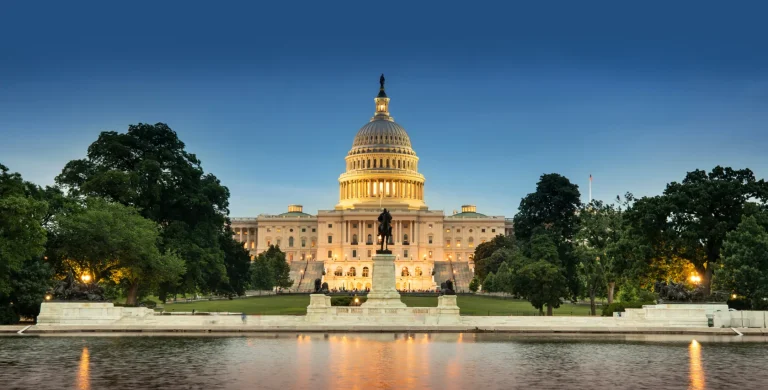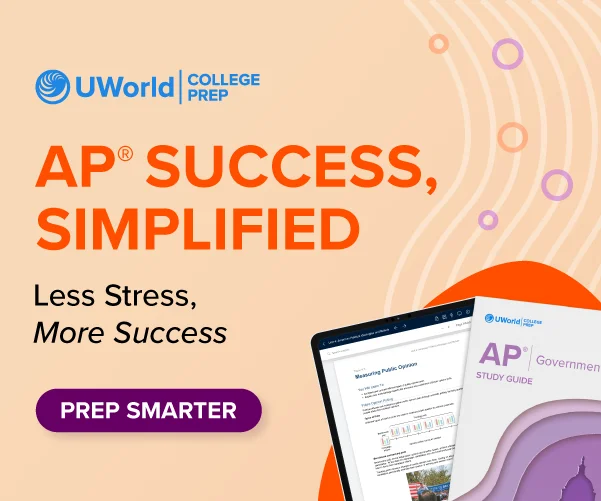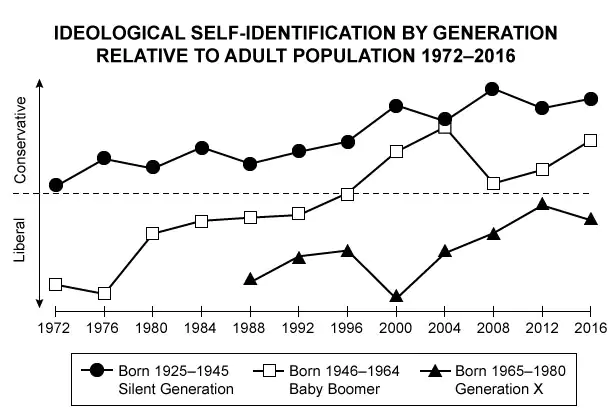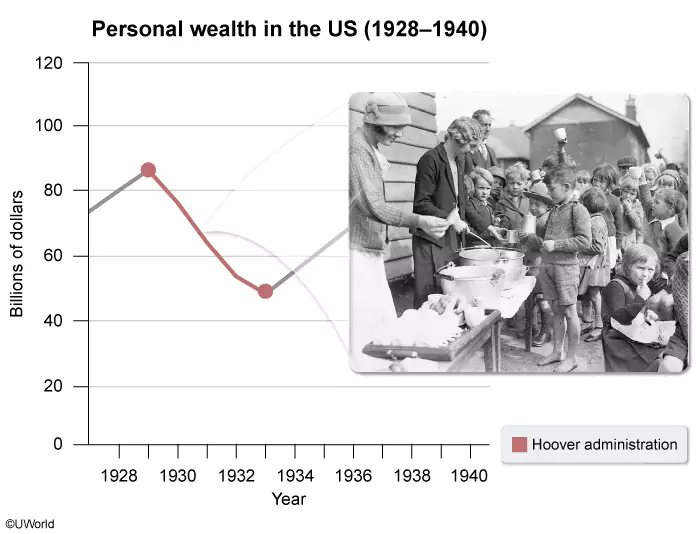Section I of the AP US Gov exam consists of 55 multiple-choice questions (MCQ), which you’ll have 80 minutes to answer. These questions cover all units from the AP US Gov course. However, note that questions from Unit 2 will appear most frequently and those from Unit 4 least frequently in this section.
About half of the AP Gov MCQs are stimulus-based, requiring you to interpret or analyze passages, graphs, charts, and possibly even political cartoons to provide an answer. The other questions do not have a stimulus, but they often briefly describe a scenario that requires you to infer or apply a concept from the course. Each question has four answer choices.
How to Approach AP U.S. Government and Politics Multiple-Choice Questions
Each type of AP Gov MCQ will test your ability to apply your knowledge of political principles and processes correctly. For stimulus-based MCQs (about half of them), be sure to read the title and author/source of the stimulus—these are important details that help you better understand the meaning of the source. For non-stimulus AP U.S. Gov MCQs, identify key terms in the question to help recall important course-related concepts.
AP United States Government and Politics Multiple-Choice Examples
Here are some AP U.S. Gov MCQs to help you assess your knowledge, identify gaps, and build confidence for the exam.
MCQ Example 1
Which of the following factors most likely led to a shift in the ideology among baby boomers over time?-
A)As a reaction to the deregulation of business in the 1980s, baby boomers became more liberal
-
B)Baby boomers became more liberal following the election of Ronald Reagan in 1980
-
C)As baby boomers aged, their values became increasingly aligned with conservative ideology
-
D)Conservative ideology began to incorporate many liberal priorities, including expanding entitlement programs
This is a Quantitative analysis MCQ. Questions like these require you to interpret data from a stimulus and consider it in a relevant political context.
Explanation:
- Political socialization refers to the process by which external influences, such as family, major events, or life experience, shape an individual's political attitudes. For example, the baby boomers' ideological trajectory shown on the graph was influenced in part by stages of life and generational shifts.
- Born between 1946 and 1964, many baby boomers grew up during the social turbulence of the 1960s and 1970s. In their youth, most embraced very liberal ideologies. In the 1980s and 1990s, many baby boomers were growing their careers and families.
- The baby boomers' ideological trajectory was influenced by life cycle and generational shifts, which contributed to political socialization. As baby boomers aged, their values changed, altering their political ideology.
- As shown on the graph, the rise of social conservativism, with its support for traditional family values, increasingly resonated with boomers. As baby boomers aged, their values increasingly aligned with conservative ideology. The conservatives' push for deregulation of business and lower taxes resulted in the election of Ronald Reagan.
- (Choices A and B) Baby boomers became more conservative after the election of Ronald Reagan in 1980.
- (Choice D) Conservative ideology promotes small government, which includes reducing entitlement programs.
Therefore, the Correct Answer is: C
Passage 1
"The legislature of the United States are vested with the great and uncontrollable powers, of laying and collecting taxes, duties, imposts, and excises; of regulating trade, raising and supporting armies, organizing, arming, and disciplining the militia, instituting courts, and other general powers. And are by this clause invested with the power of making all laws…for carrying all these into execution; and they may so exercise this power as entirely to annihilate all the state governments, and reduce this country to one single government. And if they may do it, it is pretty certain they will; for it will be found that the power retained by individual states, small as it is, will be a clog upon the wheels of the government of the United States; the latter therefore will be naturally inclined to remove it out of the way."Brutus 1, 1787
1. Bill of Rights Institute: Anti-Federalist Papers: Brutus No.1, Excerpts from Brutus 1, Annotated. Brutus 1, 1787.
MCQ Example 2
Which of the following clauses of the United States Constitution did Anti-Federalists argue could be used to entirely "annihilate all the state governments, and reduce this country to one single government"?-
A)Commerce clause
-
B)Equal protection clause
-
C)Necessary and proper clause
-
D)Full faith and credit clause
Text-based MCQs like this one ask you to interpret the author’s or a source’s perspective and consider it in a relevant political context.
Explanation:
- In 1787, the Constitutional Convention drafted a new constitution to replace the failed Articles of Confederation with a stronger federal government. In this government, the legislative branch would be empowered to make laws that would apply within all states. Anti-Federalists, however, argued such power would threaten personal liberties and could "annihilate all the state governments, and reduce this country to one single government."
- Legislative power is given to Congress through the necessary and proper clause of the Constitution. Also known as the elastic clause, it grants Congress the flexibility to carry out the enumerated powers listed in the Constitution, including:
-
A)creating and collecting taxes.
-
B)regulating and collecting tariffs on trade.
-
C)keeping a standing army.
-
D)establishing courts.
-
- Anti-Federalists feared the necessary and proper clause of the Constitution would allow Congress to destroy all state governments and create one single, centralized government.
- (Choice A) The commerce clause gives Congress authority over international and interstate commerce, but that power did not create a single, centralized government.
- (Choice B) The equal protection clause was intended to prevent states from violating African Americans' civil rights after the Civil War and is now used to protect all citizens.
- (Choice D) The full faith and credit clause states that court rulings, documents, and laws of one state must be honored in all other states.
Therefore, the Correct Answer is: C
MCQ Example 3
Which of the following constitutional amendments is most related to the issue shown on the maps?-
A)Second Amendment
-
B)Fourteenth Amendment
-
C)Seventeenth Amendment
-
D)Nineteenth Amendment
Visual source MCQs ask you to interpret a visual source and consider it in a relevant political context.
Explanation:
- The maps show the effect of the Supreme Court's decision in Obergefell v. Hodges (2015), which declared state bans on gay marriage unconstitutional.
- The Court ruled that marriage is a fundamental liberty protected by the due process clause of the Fourteenth Amendment. The due process clause prevents the states from passing laws that deprive people of "life, liberty, or property without the due process of law. "The Court ruled that states' denial of the right for same-sex couples to marry infringes upon liberty because it interferes with an individual's freedom to choose whom they wish to marry.
- In states where gay marriage was illegal, same-sex unions were denied the same legal protections as opposite-sex marriages. Therefore, the Court found that denying same-sex couples the right to marry also violated the equal protection clause of the Fourteenth Amendment, which requires the equal application of the law to all citizens.
- In Obergefell v. Hodges (2015), the Supreme Court found that state bans on gay marriage violated both the due process clause and the equal protection clause of the Fourteenth Amendment.
- (Choice A) The Second Amendment covers the right to bear arms and isn't relevant to the legalization of gay marriage.
- (Choice C) The Seventeenth Amendment instituted the direct election of senators, which has no connection to the legalization of gay marriage.
- (Choice D) The right for same-sex couples to marry is not supported by the Nineteenth Amendment, which holds that voting rights cannot be denied on the basis of sex.
The Correct Answer is: B
MCQ Example 4
In which of the following situations would a national election most likely lead to a political realignment?-
A)When an incumbent president wins reelection despite policy failures and bad press
-
B)When there are positive political relations between federal authorities and state governments
-
C)When the national economy shifts from being weak and chaotic to strong and predictable
-
D)When a political party adopts a drastic change in policies to address a national crisis
Explanation:
- In 1929, a stock market crash led to bank runs and bank failures that triggered the Great Depression. With livelihoods destroyed and families suffering, Americans blamed Republican president Herbert Hoover and congressional Republicans.
- In response to the economic crisis, the 1932 Democratic national platform proposed drastic policy changes. These proposals, which would later become part of the New Deal under President Franklin D. Roosevelt, included:
-
A)strengthening banks.
-
B)reducing unemployment.
-
C)establishing a social safety net, such as Social Security programs.
-
- These policy proposals led to an overwhelming victory for Roosevelt in the presidential election and a strong Democratic majority in Congress. The sweeping victories began decades of Democratic dominance, revealing a political realignment among voters in the critical election of 1932. Therefore, a political realignment in a national election can occur when a party adopts drastic policy changes to address a national crisis.
- The critical election of 1932 led to a political realignment because the Democratic Party adopted drastic changes in policies to address the nation's economic crisis.
- (Choice A) A situation in which an incumbent (current) president wins reelection despite failed policies and bad press doesn't reflect the political realignment of voters.
- (Choice B) Only strained, not positive, political relationships between federal authorities and state governments would contribute to political realignments.
- (Choice C) Economic strength and stability have never caused a realignment in American politics.
Therefore, the Correct Answer is: D
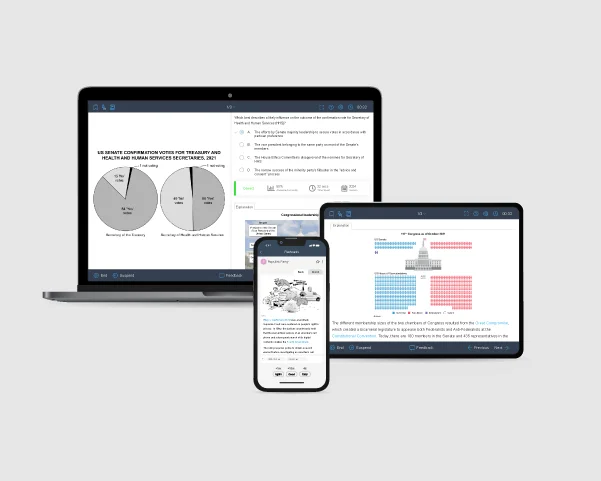
How can I practice AP U.S. Government MCQs?
One of the best ways to improve your AP Government multiple-choice questions score is to practice by answering many questions. Create a dedicated AP U.S. Government and Politics study plan and incorporate regular practice sessions into it. That way, you can make them part of your study habits and become more familiar with the kinds of information typically asked for and the language that is often used. It is a good idea at first to practice answering the questions at your own pace so you can think carefully about the answers. After you have developed your confidence and skill, it is wise to take these AP Gov multiple-choice practice questions at a pace similar to what you will experience on the exam: about one-and-a-half minutes per question.
An excellent way to review what you’ve learned and sharpen your skills is to use UWorld’s AP U.S. Government and Politics course. It contains multiple-choice questions very similar to the actual exam questions. UWorld’s U.S. Gov study guide provides a comprehensive coverage of the content and detailed explanations of questions to help you understand why answers are right or wrong. Knowing how to determine where you may have made a mistake in choosing an answer helps you avoid that mistake in the future. Additionally, the UWorld AP U.S. Government and Politics question bank gives you the option to practice with or without a timer.
Frequently Asked Questions
How are AP U.S. Gov multiple-choice questions graded?
Where can I get the AP U.S. Government and Politics past exam multiple-choice questions?
References
- (2023). AP United States Government and Politics. College Board. Retrieved December 17, 2024 from https://apstudents.collegeboard.org/courses/ap-united-states-government-and-politics
- (2023, Fall). AP United States Government and Politics Course and Exam Description. College Board. Retrieved December 17, 2024, from https://apcentral.collegeboard.org/media/pdf/ap-us-government-and-politics-course-and-exam-description.pdf
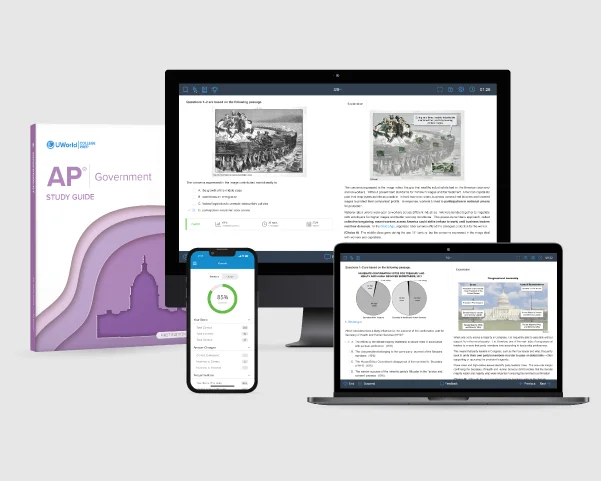
Read More About the AP U.S. Government & Politics Exam
How to Answer AP U.S. Gov FRQs
Without the right strategy, FRQs can be time-consuming. Get AP U.S. Government study tips, crucial answering strategies, and some sample FRQs here to do your best in this section!
Need effective AP exam preparation strategies? Check out our guide on the AP Gov study plan & tips, compiled by experts with all the information you need to easily earn a score of 5.
Knowing how the test is set up gives you a huge advantage. This simple guide explains the format of the AP U.S. Government exam, including the parts of the exam, question types, & more!
Best AP U.S. Gov Study Guide Comparison
Compare the best AP Gov study guides! See how Kaplan, Barron's, and Princeton Review stack up against UWorld for comprehensive exam prep.
Best AP U.S. Gov Prep Course Review
Discover the best AP U.S. Gov prep courses! This in-depth review helps you compare options and pick the course that meets your needs.
How to Self-Study for AP U.S. Gov
Learn effective tips and strategies to self-study for the AP U.S. Gov exam. Build confidence, master core concepts, and achieve a high score independently too.
